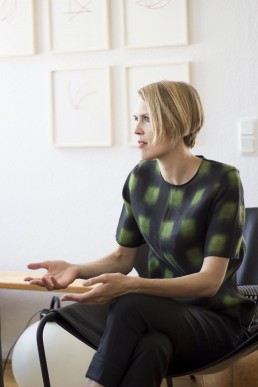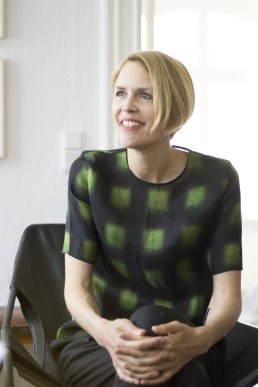Interview: Kristina Leipold of Google Arts and Culture
For this series Art Insiders interviewed 5 Berlin-based women that work on the intersection of art and digital technology. Find out what these frontrunners have to say about Berlin’s art and tech scenes, the current status of the art world, and in what ways digital technology is affecting it.
Kristina Leipold worked until recently as a project manager for Google Arts and Culture overseeing the German speaking market and now as a consultant for digital education and cultural communication. She works closely with many institutions with the goal to present analogue content in a digital way and increase the accessibility of culture.

Could you tell us bit about yourself and your work at Google Arts and Culture?
I’ve always worked on the intersection of art and technology. After my studies I started working for a German software company, after which I switched to culture and worked for the Goethe- Institut. Then I was handling relations with German businesses on cultural engagement, wrote a book in between, and taught architecture and urban development at a university. My interests are very broad as you can tell. Two years ago I started working at Google Arts and Culture, and my focus has been more on the arts since then.
My job at Google Arts and Culture lies a bit in between a project manager and a consultant. I work closely with experts and curators from various institutions to support them in presenting their analogue content in a digital way. I help them creating stories around their collections and improving accessibility to their collections.
What is the wider objective of Google Arts and Culture?
Google Arts and Culture is very much part of Google’s DNA, where the aim is to organize the world’s information and make it universally accessible and useful. Google Arts and Culture started out with 17 museums about 6 years ago, and currently includes more than 1400 museums and archives that all participate with the mutual goal to improve access to arts and culture to anyone anywhere.
Together with these institutions we experiment with Google’s technology, and we test and develop new ways of how tech can support the arts and culture industry. Digital technology can improve accessibility to art in two ways: firstly, for those who have limited access to art and culture for financial or logistical reasons; and second, for those who feel intimidated or alienated by art galleries or museums. The art sector can often seem elitist and I think technology really has the power to break those barriers. Technology can be the first step in exploring an interest in a certain artist for example, which can then lead to them visiting an art show in person.
“DIGITAL TECHNOLOGY CAN IMPROVE ACCESSIBILITY TO ART. THE ART SECTOR CAN OFTEN SEEM ELITIST AND I THINK TECHNOLOGY REALLY HAS THE POWER TO BREAK THOSE BARRIERS.”
Many people in the art world are skeptical towards mixing art and tech, and fear that digital innovation is changing or trying to replace those authentic experiences around art.
Most of this weariness comes from the art market which traditionally has been very opaque. A lot of information on pricing and ownership of works are being kept in the dark on purpose, and the art world moving more into the digital realm brings a certain transparency to the market that many people aren’t happy about. On the other side, this fear comes from the many public art institutions that tend to be quite traditional in their structure, with little experience with new media and technology, and often no digital strategy whatsoever. These institutions often don’t have the knowledge or capacity, which is where we can offer support. We introduce new technologies and provide assistance in applying them in ways that are beneficial for institutions, and in order to reach new, younger audiences.
Most museums can only show 5-10% of their collections at once, and the rest is hidden away in archives. More and more institutions are now putting images of these treasures into an online database, available for everyone to access at any time. Once an image is online, all these copyright laws must be taken into account that consider the rights of the artist, the institution, the collector who owns the work, and even of the photographer of the image. Museums are often afraid to publish their content online, as they think visitors will stop coming when can the collection in digital form, but the opposite has shown to be true. Several US studies showed that the more content about an exhibition is put online, the more visitors the exhibition will attract. For the younger generation, if something isn’t online, then it doesn’t exist. Everything has an online presence nowadays, and it’s just the way to show the world you exist and that you’re relevant.
I don’t think there is the need for this skepticism. We shouldn’t look at it as technology ‘replacing’ art, but rather as tech providing us with additional ways of experiencing art, and especially, providing access to those who otherwise wouldn’t have had it. This fear of technology is holding back a lot of institutions in galleries, and is preventing them from seeing the benefits.
” I DON’T THINK THERE IS THE NEED FOR THIS SKEPTICISM. WE SHOULDN’T LOOK AT IT AS TECHNOLOGY ‘REPLACING’ ART, BUT RATHER PROVIDING US WITH ADDITIONAL WAYS OF EXPERIENCING ART, AND PROVIDING ACCESS TO THOSE WHO OTHERWISE WOULDN’T HAVE HAD IT.”
What are some specific ways in which Google Arts and Culture has implemented digital strategies within institutions?
Google offers both the Google Arts and Culture platform and app as well as certain technologies that museums and institutions can both make use of free of charge. These technologies can mean creating virtual tours through the museum, providing museums with 360-degree imagery of their collections, or creating VR tours that can be experienced with Cardboard and creating full VR experiences. The platform itself includes several tools, like the storytelling tool which allows museums to create online exhibitions, tell stories about the show, include audio of the curator and a zoom-in option, create teasers for future exhibitions, or archive all past exhibitions.
All this multimedia brought together makes for an important tool that allows museums to create high quality content free of cost. The content can be adjusted depending on the audience, which allows museums to personalize the experience according to what audience segment they want to reach. These virtual tours combined with VR really creates this feeling of being in the middle of the room, seeing the hanging of the works, and experiencing how the curation is done. For curators or museum staff it’s very useful to be able to store these digital exhibitions and revisit it for reference for future exhibitions.

What are some institutions that you consider pioneers in terms of digital innovation in the arts and culture sector?
We are currently working on numerous innovative projects with various institutions all over Germany. For example, the National Museums in Berlin were one of our first partners in Germany, and are this huge association of museums, with each museum housing a very different collection, with very different needs and identities. Over the years we worked together on several themes and technologies and I’m curious to see what will be next. They are a very open-minded partner eager to embrace change. Furthermore, the MoMA and Smithsonian in New York both set a great example in terms of digital innovation. From the European museums, I think the Städel in Frankfurt, the Jewish Museum in Berlin, and the Rijksmuseum in Amsterdam are doing a great job producing online content to support their collections.
About Art Insiders
Art Insiders is a multidisciplinary agency focused on the arts and culture sector.
Website: artinsiders.org
Get your free copy of Artland Magazine
More than 60 pages interviews with insightful collectors.